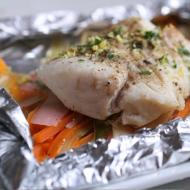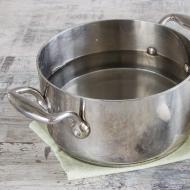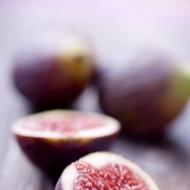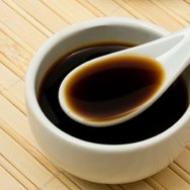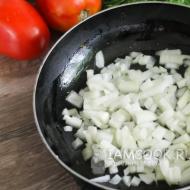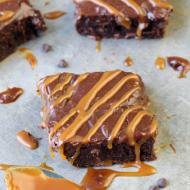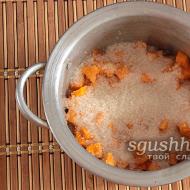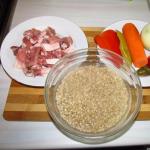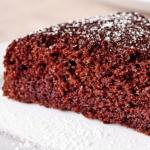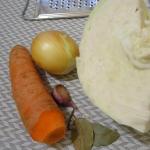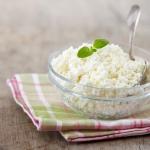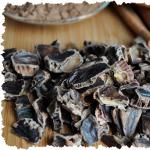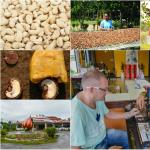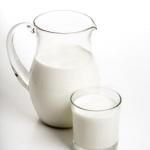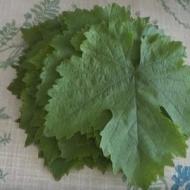
On the benefits of honey extract from rutabagas. Rutabaga - what kind of vegetable is it, useful properties and calorie content. Salad with swede, radish and ham
Rutabaga is a popular vegetable overseas, but in Russia for some reason it is of interest to a small circle of people. It belongs to the extensive Cruciferous family, which includes plants known for their anti-cancer properties: Brussels sprouts, etc. Other names: "Swedish", or "yellow turnip".
Rutabaga supposedly originated in Russia as a hybrid between turnip and wild cabbage. It took a long time to be recognized and loved in other parts of the world. In the UK, it has been associated with poverty and hunger for centuries. Not too fair, because during the Second World War, it was the swede that saved the lives of many Englishmen.
The flesh is light yellow, crisp and quite sweet, with fresh notes. Its slightly spicy taste softens during cooking and other types of heat treatment. The skin is yellow, turning purple at the top. Along with the root crop, the leaves of the plant are eaten.
The benefits of rutabaga, like other members of the cruciferous family, are respected by nutritionists. The composition includes vitamins C, E and K, B vitamins, potassium, phosphorus, zinc, calcium, magnesium, manganese and iron.
- Contains valuable phytochemical compounds glucosinolate with anti-cancer properties. It prevents the development of malignant tumors, neutralizes carcinogens and promotes the elimination of toxins from the liver.
- One serving of a vegetable contains up to 50% of the daily requirement of vitamin C, the beneficial qualities of which are known even to people far from medicine. This compound, along with carotenoids, provides antioxidant protection to the body.
- Beneficial effect on the digestive system: promotes the production of bile and fights Helicobacter pylori (Helicobacter Pylori). These bacteria settle on the walls of the stomach and intestines, causing ulcers, gastritis, and even stomach cancer. The root vegetable improves metabolism due to the high concentration of fiber: 12% of the daily value in one serving.
- Contains eye-friendly carotenoids. Together with vitamin C, it nourishes and protects the visual organs from the aggressive activity of free radicals, reduces the risk of cataract formation.
- Rutabagas are a great source of zinc (0.48 mg per serving, or 6% of the DV for women and 4% for men). Without this mineral, our body cannot produce important enzymes and protect itself from the harmful effects of heavy metals.
- Vitamin C in the composition of the root vegetable is useful not only in the fight against free radicals, but also in the treatment of asthma patients. Regular consumption of this member of the cruciferous family reduces the intensity of attacks and reduces shortness of breath.
- Delivers good doses of potassium to the body, thereby reducing the likelihood of a heart attack. Normalizes blood pressure and fights water retention. Helps reduce blood cholesterol levels due to fiber.
- Doctors note useful qualities for constipation: dietary fiber stimulates intestinal motility in a natural way. But the use in large quantities of people suffering from flatulence is contraindicated.
- The swede owes its dietary properties to its minimal calorie content and rich nutritional composition. Promotes weight loss and prevents the development of type 2 diabetes. An excellent alternative to potatoes for diabetics, because it has 20% less carbohydrates.
- It contains less vitamin K than carrots, but even this amount gives the root vegetable valuable properties: improves blood quality and promotes blood clotting, increases bone density and prevents fractures.
Other useful properties:
- prevents alopecia (baldness);
- relieves symptoms of PMS;
- strengthens bones, treats osteoporosis;
- fights migraine;
- protects against Alzheimer's disease;
- increases milk production during breastfeeding;
- prevents epileptic seizures;
- increases endurance during intense physical exertion;
- stimulates healthy cell regeneration.
How to clean
- Choose firm root crops with smooth skins without wrinkles or other damage.
- Wash the swede thoroughly under running water.
- Cut in half to make it easier to remove the top purple part. Use the sharpest knife for this.
- Free the halves from the thick skin with a paring knife - this is problematic to do by hand.
- Cut out all the hard inclusions found in the pulp with the tip of a knife: they will not harm your health, but they will spoil the taste of the root crop, make it bitter.
- Some supermarkets sell turnips coated with wax. Fortunately, this does not affect its taste.
Fresh root crops are stored in the refrigerator in a hermetically sealed bag for up to one week.
Rutabaga is baked, fried, steamed, boiled and stewed. The fastest cooking method: in the microwave. Place vegetable cubes in a baking dish, add 3 tbsp. l. water and cook for 7-9 minutes until soft. Then let stand for 3 minutes. Ready!
Possible harm
In most cases, this vegetable is completely safe to consume, but it is harmful to people with kidney disease due to the content of mustard oil, which causes increased gas and flatulence.
If you are allergic to turnips, cabbage, and other cruciferous vegetables, check with your doctor before adding the root vegetable to your diet.
Rutabaga is an excellent food for vegetarians who are limited in plant sources of complete protein. The composition of the Swedish turnip contains all the amino acids necessary for the body to build new cells and regenerate existing ones. Evaluate the beneficial properties of this root crop.
Rutabaga has been used in agriculture since ancient times, and to this day this root crop continues to be quite popular. This vegetable is a kind of hybrid of turnip and cabbage. Some scientists believe that this crossing happened on its own in natural conditions, while others refer to facts confirming that it was bred by Swedish breeders back in the 17th century.
Outwardly, this vegetable is a bit like its close relative - turnips, but differs from it in slightly larger sizes. Its upper part has a lilac hue, the lower one is greenish.
Its flesh is light, soft, sweet. It is completely devoid of the bitterness that is characteristic of turnips. Rutabaga loves a cool climate and it is in such conditions that it turns out especially tasty. The process of its maturation lasts three months. But a ripened vegetable in dry conditions can be stored throughout the year.
Compound
This root crop boasts a large amount of easily digestible carbohydrates, vegetable proteins and dietary fiber.
Rutabaga contains so many vitamins and microelements that it can easily overtake many other vegetables in terms of usefulness.
The sugar in it is presented in the form of fructose, and therefore this vegetable is highly recommended for use by diabetics.
As for the vitamin composition, here we can find vitamins A, H, E, C and a full range of vitamins of groups B and PP. It is also rich in beta-carotene, calcium, magnesium, potassium, sodium, phosphorus and iron.
The content of vitamin C in it is greater than in other vegetables, and this vitamin is preserved not only throughout the winter, but also when cooking the vegetable. That is why the root crop is an indispensable means of maintaining immunity in the winter-spring period.
Compared to others, this vegetable has an extremely high level of potassium, calcium, and iodine. Mustard oil, which is part of this root crop, has a detrimental effect on harmful bacteria and adds some piquancy to dishes. 
calories
A close relative of the turnip, it resembles it both in flavor and composition. Just like turnips, this vegetable has a very low calorie content - 100 g of the product contains only 37 kcal. That is why it is recommended to eat it regularly for all those who follow their figure.
Beneficial features
The benefits of this vegetable are obvious:
- Due to the high percentage of calcium content, it is indicated for use among people suffering from softening of the bone tissue. It will also not interfere with all those who suffer from a lack of calcium in the body or are often forced to go to the dentist with certain dental problems.
- It is recommended to include it in your diet for patients with atherosclerosis, as it speeds up metabolic processes and removes “bad” cholesterol from the body.
- An infusion prepared from its seeds is excellent for gargling and rinsing the mouth with inflammatory processes. Taking this infusion internally speeds up the process of getting rid of measles.
- Rutabaga juice has been used as an effective wound healing and anti-inflammatory agent. Due to its antibacterial properties, it was used in ancient times to treat burns and purulent wounds.
- Root crops have a positive effect on the work of the food system. Experts recommend using it for constipation, as well as a diuretic.
- This vegetable helps to reduce swelling, and therefore it is excellent for cardiovascular diseases and kidney problems.
- Another positive property of this root crop is the ability to liquefy sputum. It can turn a dry cough into a productive one and thus speed up recovery. It is also recommended for chronic diseases of the bronchi and lungs.
- Due to the high content of vitamin C, the use of root vegetables improves immunity.
- Rutabaga also has anti-cancer properties.
- This vegetable should be regularly consumed with iron deficiency anemia, which is why it is especially indicated for pregnant women.

Use in medicine
Due to its properties, this useful root crop is widely used in traditional medicine:
- If you have a cold and suffer from a dry cough, then drink swede juice mixed with honey in proportions of 2 to 1. You can get the juice by passing this vegetable through a meat grinder. Take 1 teaspoon at least three times a day.
- People suffering from bronchitis, asthma, pneumonia, as well as chronic respiratory problems should include in their diet a vegetable stewed in butter with honey.
- To increase the level of calcium in the body, you can drink swede juice with honey. Only in this case, the proportion is different - 1 tablespoon of honey per 0.5 cup of swede juice. Take twice a day.
- In order for it to contribute to the release of radionuclides from the body, the root crop should be boiled in slightly salted water, and then eaten with sour cream.
- If you want to use it as a remedy for burns, then mix its juice with honey in equal proportions and regularly lubricate the affected areas with this remedy.
- In order to increase immunity, improve digestion, and also for the prevention of various diseases, include various swede dishes in your daily diet.
Rutabagas for weight loss
Today, this root vegetable is part of many diets for weight loss. It is able to significantly increase intestinal motility, improve the digestion process and speed up the metabolism, therefore it is very effective in combating extra pounds. 
Hazardous Properties
Despite all the useful properties, its use should be approached deliberately. Due to the high fiber content, this root vegetable is contraindicated for people with acute diseases of the stomach and intestines.
How to use
There are a lot of ways to use this root crop, and therefore you can cook anything you want from it.
For example, it can be used in various stews, soups and casseroles.
It can be fried and eaten as a side dish for meat and fish dishes. If you do not like fried food, then just boil and mash it. This vegetable tastes somewhat like a potato, but, unlike it, is more suitable for protein foods due to its low starch content.
It also makes excellent salads, the regular use of which will allow you to quickly and easily get rid of extra pounds. You can use it in salads both raw and boiled-steamed.
Turnip tops, the benefits of which are also rather big, can be used both fresh and dried. Fresh tops are added to salads, dried tops make an excellent seasoning for soups and main dishes.
cultivation
Rutabaga is a biennial plant that loves bright light and abundant watering. Its planting can be carried out both with the help of seeds and seedlings. The soil for planting should be moist and rich in organic fertilizers.
It is actively grown not only in Russia, but also in the Scandinavian and Baltic countries. There are a variety of varieties of swede. For example, in Russia, the most common is Krasnoselskaya. In addition, gardeners also grow root crops of varieties such as Swedish, Kaya, Marian, Ruby, Lizi, etc.
It is of two types - feed and dining. Both of them can be safely eaten. The only difference is that the canteen has a softer pulp and a pleasant taste, while the fodder has a better yield and is less demanding to care for. 
- It was the swede that was Goethe's favorite vegetable, which he quite often ate in a variety of variations.
- In the Swiss city of Richterswil, from ancient times to the present day, the Day of the swede is celebrated annually. Recently, this tradition has also reached Russia, where it settled in the town of Ivanovo.
- In Finland, swede casserole is a traditional Christmas dish.
This is swede, the beneficial properties and contraindications of which should be remembered and taken into account by all those who monitor their health and figure.
Not many people know about the beneficial properties and possible contraindications of rutabaga. Despite the fact that this vegetable contains a huge amount of vitamins, the root crop is not so common on our tables. And in vain, it can be used both in cooking and in traditional medicine.
Rutabaga has a special taste and amazing aroma. It can be consumed raw, fried and baked. In addition, rutabaga juice is also very useful. To get the most benefit from a vegetable, you need to familiarize yourself with its properties in advance.
- Used to prevent cancer. Regular consumption of vegetables helps to cleanse the body of toxins, and the blood of carcinogens.
- Helps improve digestion. The root crop is rich in fiber, which prevents constipation, accelerates the breakdown of fats.
- Contains zinc. This component helps the body fight infections. Zinc is especially useful for women during pregnancy: the element is responsible for ensuring that the baby's organs are properly formed.
- Rutabaga juice has an anti-inflammatory effect. It is often used for burns, skin diseases. If you wipe your face with this juice every day, it will be possible to prevent the appearance of acne and inflammation. In addition, vegetable puree is often included in various masks.
- An excellent tool in the fight against excess weight. The product is low in calories. Due to the high fiber content, appetite is reduced. People who dream of a slim figure should pay special attention to the vegetable. Its constant use improves the functioning of the digestive system, normalizes metabolism.
- Useful properties of swede help with colds, however, you need to remember about some contraindications. The juice is used as an expectorant. Mouth rinses help stop inflammation.
- Reduces the risk of heart disease. Thanks to vitamin K, you can fight the causes of a heart attack. Potassium helps lower cholesterol levels and reduce the risk of heart attacks.
- Helps strengthen immunity. The product contains a huge amount of vitamin C, which is so necessary for the body.
- Rutabaga is a source of antioxidants. Due to the rich composition of vitamins, it can fight various diseases. In addition, it will be possible to preserve the youthfulness of the skin, prevent the appearance of wrinkles, and get rid of age spots.
- Helps lower blood pressure.
- Takes care of bone health. The vegetable is rich in various vitamins and nutrients. These components are necessary to maintain bone tissue in a normal state. In addition, regular consumption of vegetables reduces the risk of osteoporosis.
- Calcium is essential for healthy teeth.
- Rutabaga can be used to treat and prevent diabetes. The root crop can be a substitute for potatoes - it has a positive effect on the digestive system.
- Source of protein for vegetarians. For people who have limited themselves in the use of meat, swede will help make up for the lack of vitamins. In addition, the product is responsible for the growth, development and recovery of muscles.

Contraindications
Despite the fact that swede has many useful properties, it is worth remembering some contraindications. Their list is small. However, in order not to harm your health, you should still familiarize yourself with them in advance.
It is necessary to refuse the use of the product in the following cases:
- For digestive problems. A vegetable can provoke an exacerbation of diseases, which can lead to increased gas formation.
- With an allergy to a root crop.
- At .
- During pregnancy, the product should not be abused.
- Children up to 6 months. Only after six months can you include the root crop in the child's diet, but only in boiled form. Fresh, you can use the product after a year.

The product is a storehouse of vitamins and nutrients. The scope of application is quite diverse. Often found in cosmetology, cooking, folk medicine. In order to get the maximum effect from the use of the product, you should familiarize yourself with beauty recipes in advance.
The product is often included in various masks. With the help of a root crop, you can improve the complexion, make the skin healthier and younger. There are a lot of recipes for masks, we will consider only a few of them.
Moisturizing mask
To prepare it, you need to grind a small piece of swede, add sour cream, 5 grams of honey, cucumber juice. Mix the mixture, apply on face, keep for 15 minutes. You need to remove the mixture from the face with the help of tea leaves.
The mask will help get rid of acne and even out skin tone. In addition, it nourishes the skin well.

Vitaminized mask
A real find for owners of dehydrated skin. The composition is so rich in vitamins that after the first application the result will be visible.
To prepare the composition, you need to take 40 grams of chopped swede, add 5 grams of honey and 5 grams. Mix well, add 50 grams of cottage cheese.
Apply the mask on the face, keep for 10 minutes, rinse with cold water.
Turnip juice to fight freckles
A great tool to help get rid of freckles. In addition, it can be used for hair care. Regular rubbing the juice into the scalp helps accelerate hair growth.
Despite some contraindications, the beneficial properties of swede still attract the attention of many people. If you want to look young and attractive, this root crop will be a great helper.

Rutabaga - a useful root crop
The main thing is to observe the measure in everything. In this case, the side effects will not be terrible.
Rutabaga is used in many areas, helps to fight various diseases. Having become acquainted with the beneficial properties of the product, it will be possible to strengthen health, improve well-being, feel a surge of vigor and strength.
Useful properties and recipes of swede
What do you think, what was grown and consumed in Russia, before potatoes were first brought from Holland? One of the most common vegetables, which in some ways is very reminiscent of potatoes, has become a swede. It is about her and her beneficial properties that we will talk today.
Unfortunately, swede is unfairly forgotten, and today it is quite often confused with fodder beets. But, this is a completely different plant that belongs to the cabbage family. Outwardly, rutabagas strongly resemble turnips. In the middle, the swede has a juicy, sweet yellow flesh.
The root crop is consumed raw or cooked, combining it with various products. The popularity of rutabaga remains prevalent in a number of European countries, for example among Germans or Swedes. Rutabaga has received such wide distribution due to its useful properties and taste.
In cultivation, the root crop is completely unpretentious - swede is very cold-resistant, able to grow in the ground at low temperatures from 1 ° C to 3 ° C. In addition, swede is not at all afraid of extreme heat or drought, but the concentration of nutrients is somewhat reduced. That is why, in the southern regions of Russia and Ukraine, turnips are planted early in order to harvest before the onset of hot weather.
Nutritional value and calorie content of swede
The calorie content of swede is about 37 kcal per 100 g of product. This is approximately 1.81% of the required rate per day. If you use one root crop daily, weighing about 300 g, a person receives about 110 kcal per day.
In terms of nutritional value, swedes contain a moderate amount of carbohydrates and proteins. Nutritional information can be seen in the table below.

Useful composition of swede
Rutabaga is rich in dietary fiber and easily digestible carbohydrates. It contains vegetable proteins, and very little fat in the form of mustard oil. The composition of the root crop is very useful, because it contains phosphorus, magnesium and sodium, a lot of potassium and iron, and, of course, there is a lot of calcium in the swede.

In order for the swede to be beneficial for the body, it is necessary to learn how to choose it correctly. So, give your preference to smooth and firm rutabaga fruits that lack fibrous roots. If you buy a soft turnip, most likely, even after boiling or other heat treatment, it will be tough and not tasty.
Useful properties of swede
The moderate content of nutrients and vitamins in the composition of the swede guarantees it a large number of useful properties. So, swede is considered an excellent source of strength and energy, it helps in the fight against vitamin deficiency on cold winter and spring days. Especially useful swede in the fight against diseases such as dysbacteriosis or constipation.
Rutabaga has a diuretic effect, helps to get rid of puffiness, and is useful for the prevention of hypertension. It is useful for children and adults to consume swede during a cold, as it has an anti-inflammatory effect. During bronchitis, pneumonia and its forms, the vegetable is boiled and consumed with honey. The same recipe is used to treat chronic diseases of the respiratory organs.

In the fight against measles, sore throats and sore throats, crushed seeds brewed in warm water are used to rinse it. Since rutabaga contains mustard oil, it is used as an antimicrobial agent. For burns, purulent wounds and inflammation, swede compresses will be useful. To prepare a compress, it is enough to grate the root crop and put it on gauze.
The composition of the swede contains a sufficient amount of carbohydrates, which in their content are fructose. Therefore, the product can and should be used by diabetics without problems.

Also, swede is useful for those who want to get rid of extra pounds. The root crop removes excess fluids from the body, accelerates intestinal motility, and stabilizes its work. For those who want to lose weight, you should pay attention to recipes for stews, salads and swede puree. The root crop goes well with mushrooms or eggs.
Harm and contraindications of swede
And now about the unpleasant - the dangers of swede for the body. People with diseases of the digestive system, it is better to refrain from eating this root crop, especially during an exacerbation of chronic diseases. The product contains coarse plant fibers, which lead to irritation of the mucous membrane.

The tip of the swede has suction roots, which during the growth period can accumulate carcinogens. Therefore, during use, cut off the spine without sparing it. And, of course, swede may not be individually tolerated by the body.
Rutabaga Recipes
Rutabaga is widely used in cooking, dietary and baby food. We will talk about several useful and simple recipes with the preparation of swede.
Puree with swede and carrots

For cooking you will need:
Rutabaga 90 g;
Carrots 50 g;
Leek 10 g;
Butter 3 g;
Milk 25 ml.
Wash vegetables, peel, cut into pieces. Put in a saucepan, pour a small amount of boiling water and cook over low heat for 10-15 minutes until the vegetables are soft. Grind the prepared vegetables with a blender, add butter and dilute with milk to the desired consistency. If the child is allergic to milk, then dilute the puree with a decoction.
Rutabaga soup
Try making swede soup. It will turn out a tasty and juicy, fragrant and satisfying dish for the whole family. For those who do not eat meat, there is no better product than rutabagas. For cooking you need:
Young swede - 1 pc.
Carrot - 1 pc.
Onion - 1 pc.
Petiole celery - 100 g;
Barley groats - 100 g;
Turmeric - 0.5 tsp;
Spices - to taste.

Wash the rutabaga, dry it and cut into pieces. Place in a saucepan, fill with water, add chopped onions and carrots. You can fry them separately if you like. Add celery (pieces) and greens there. Bring to a boil over low heat, then add the well-washed barley grits, turmeric and spices. Cook over low heat until the cereal is cooked. When the swede becomes transparent, the porridge will add thickness to the soup, and the turmeric will add a juicy shade, the soup can be turned off and served.
Harvesting rutabagas for the winter
In order to prepare swede for the winter and make preservation, it is enough to prepare the ingredients: young swede - 1-2 pieces, carrots - 3 pieces, onions - 1 piece, greens - to taste, zucchini - 1 piece, vinegar 9% - 1 tablespoon, salt - to taste, sugar - to taste, vegetable oil - 50 g.

All vegetables are washed, cleaned and cut. We cut the onion very finely, everything else - cubes. First, fry the carrots and rutabaga so that they soften a little. Add zucchini, greens, onion and sugar with salt, fry, and then simmer for 40 minutes over low heat. Rutabagas and carrots should be very soft. 5 minutes before the end of cooking, add vinegar and mix. We lay out the mixture in prepared sterile jars and close for the winter.
More useful products:
| - | |
Rutabaga is a root vegetable that belongs to the cruciferous family, like broccoli and cauliflower. This is a hybrid of turnip and cabbage, which was obtained in Sweden in the 17th century.
Young root vegetables can be eaten raw, they have a delicate and sweet taste. Ripe rutabagas are boiled, mashed, fried, steamed, baked and marinated. Not only tubers are eaten, but also young greens.
Rutabaga is a source of fiber, vitamin C and potassium. Rutabaga seed powder is a folk remedy for cancer because it is high in anti-carcinogenic compounds.
The composition and calorie content of swede
Rutabaga contains niacin, thiamine, vitamin B6, glucosinolates and phytosterols.
Composition 100 gr. rutabagas as a percentage of the daily norm:
Rutabaga is a source of manganese, magnesium, calcium, zinc, carotene.
Calorie content of swede - 37 kcal per 100 gr.
The beneficial properties of swede help reduce oxidative stress and prevent the development of chronic diseases.
Thanks to potassium, swede lowers blood pressure, and the fiber content helps lower cholesterol levels. People who eat swede have a reduced risk of ischemic stroke.
Rutabaga is effective in fighting free radicals. It contains carotenoids and improves eyesight.
The use of swede for weight loss is well known, as it contains a lot of fiber. It is necessary for the vital activity of beneficial bacteria in the intestines, helps with constipation and contains few calories.
Because low serum potassium levels are closely associated with glucose intolerance, rutabaga helps prevent diabetes.
The vitamin C in swede is important for collagen production, skin and connective tissue healing.
Rutabaga contains sulfur-containing antioxidants that reduce the growth of cancerous tumors. The vegetable contains carotenoids and vitamin C, which are important in fighting free radicals and preventing healthy cells from mutating. Rutabaga provides the body with zinc, which is essential for enzyme synthesis, protein structure strengthening, immune support, and protection against the effects of oxidative stress.
Recipes with swede
Harm and contraindications of swede
The vegetable contains raffinose, which is a complex sugar that causes intestinal discomfort, bloating and flatulence. If you're allergic to cruciferous vegetables, check with your doctor before adding rutabaga to your diet, although it's rare to be allergic.
How to choose a product
Choose a vegetable that is firm, smooth, and heavy for its size. If the swede feels soft or spongy, then don't buy it because it's old or rotten.
In markets, turnips are often covered with a layer of wax. Wax is applied at the time of harvest to keep the vegetable from losing moisture and drying out, but this makes cleaning difficult.
In winter, swede is more affordable and tastier. Rutabaga leaves can be harvested along with root crops.
How to store the product
Before storing rutabagas, cut off the foliage with a sharp knife. Root crops can be stored for about 4 months at a temperature slightly above zero in a room with a humidity of 90-95%. It is best to store turnips in the refrigerator, wrapped in a slightly damp tea towel in the vegetable drawer.
You can freeze root vegetables in season. You need to cut them into cubes or thin sticks, blanch in boiling water for 3 minutes, strain and spread until dry. Then place in a single layer on a tray and put in the freezer. Shelf life - 1 year.
Rutabaga roots can be eaten raw or pickled. They can be prepared similarly to potatoes - baked, fried, boiled and steamed. The vegetable is used in soups, stews and casseroles.

